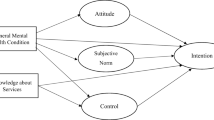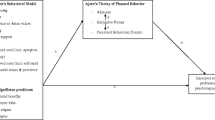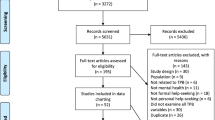Abstract
Purpose
Professional mental health help-seeking is generally low among Chinese populations with mental problems, and this may also the case following natural disasters. The help-seeking intention within Chinese populations exposed to natural disaster remain unclear. This study aims to explore the intention to seek professional mental health help utilizing an extended theory of planned behavior (E-TPB) model among Chinese college students exposed to Typhoon Hato.
Methods
In total, 1876 Chinese participants were recruited using convenience sampling at baseline and 817 participants (mean age = 20.9 years, SD = 2.8, 28.4% male) were followed up 6 months later. The online questionnaire was applied to measure six constructs including help-seeking intention, attitude, subjective norm, perceived behavioral control, self-stigma, and social stigma.
Results
Structural equation modeling showed the subjective norm (β = 0.374, p < 0.001) was the strongest predictor of help-seeking intention, followed by attitude (β = 0.271, p < 0.001) and perceived behavioral control (β = 0.213, p < 0.001), and self-stigma (β = − 0.117, p = 0.006). Unexpectedly, public stigma was not significantly associated with help-seeking intention. Moreover, multi-group analyses revealed paths of the E-TPB model were invariant across gender.
Conclusion
These results supported the efficacy of the E-TPB model in explaining help-seeking intention and emphasized the importance of subjective norm (e.g., support or disproval from significant others or society) in influencing help-seeking intention among Chinese young adults exposed to a natural disaster.


Similar content being viewed by others
References
Hall BJ, Xiong YX, Yip PS et al (2019) The association between disaster exposure and media use on post-traumatic stress disorder following Typhoon Hato in Macao, China. Eur J Psychotraumatol 10:1558709. https://doi.org/10.1080/20008198.2018.1558709
Neria Y, Galea S, Horris FH (2009) Mental health and disasters. Cambridge University Press, Cambridge
Wang W, Fu W, Wu J et al (2012) Prevalence of PTSD and depression among junior middle school students in a rural town far from the epicenter of the Wenchuan earthquake in China. PLoS ONE 7:e41665. https://doi.org/10.1371/journal.pone.0041665
Zhen Y, Huang ZQ, Jin J et al (2012) Posttraumatic stress disorder of Red Cross nurses in the aftermath of the 2008 Wenchuan China earthquake. Arch Psychiatr Nurs 26:63–70. https://doi.org/10.1016/j.apnu.2011.02.004
Jia Z, Tian W, He X et al (2010) Mental health and quality of life survey among child survivors of the 2008 Sichuan earthquake. Qual Life Res 19:1381–1391. https://doi.org/10.1007/s11136-010-9703-8
Ajzen I (1991) The theory of planned behavior. Organ Behav Hum Decis Process 50:179–211. https://doi.org/10.1016/0749-5978(91)90020-T
Armitage CJ, Conner M (2001) Efficacy of the theory of planned behaviour: a meta-analytic review. Br J Soc Psychol 40:471–499. https://doi.org/10.1348/014466601164939
Conner M, Armitage CJ (1998) Extending the theory of planned behavior: a review and avenues for further research. J Appl Soc Psychol 28:1429–1464. https://doi.org/10.1111/j.1559-1816.1998.tb01685.x
Mak HW, Davis JM (2014) The application of the theory of planned behavior to help-seeking intention in a Chinese society. Soc Psychiatry Psychiatr Epidemiol 49:1501–1515. https://doi.org/10.1007/s00127-013-0792-x
Mo PK, Mak WW (2009) Help-seeking for mental health problems among Chinese: the application and extension of the theory of planned behavior. Soc Psychiatry Psychiatr Epidemiol 44:675–684. https://doi.org/10.1007/s00127-008-0484-0
Corrigan P (2004) How stigma interferes with mental health care. Am Psychol 59:614–625. https://doi.org/10.1037/0003-066X.59.7.614
Vogel DL, Wade NG, Haake S (2006) Measuring the self-stigma associated with seeking psychological help. J Couns Psychol 53:325–337. https://doi.org/10.1037/0022-0167.53.3.325
Vogel DL, Bitman RL, Hammer JH, Wade NG (2013) Is stigma internalized? The longitudinal impact of public stigma on self-stigma. J Couns Psychol 60:311–316. https://doi.org/10.1037/a0031889
Yang J (2013) “Fake happiness”: counseling, potentiality, and psycho-politics in China. Ethos 41:292–312. https://doi.org/10.1111/etho.12023
Nam SK, Choi SI, Lee JH et al (2013) Psychological factors in college students’ attitudes toward seeking professional psychological help: a meta-analysis. Prof Psychol Res Pract 44:37–45. https://doi.org/10.1037/a0029562
Cheang SI, Davis JM (2014) Influences of face, stigma, and psychological symptoms on help-seeking attitudes in Macao. PsyCh J 3:222–230. https://doi.org/10.1002/pchj.61
Pheko MM, Chilisa R, Balogun SK, Kgathi C (2013) Predicting intentions to seek psychological help among Botswana university students: the role of stigma and help-seeking attitudes. Sage Open 3:1–11. https://doi.org/10.1177/2158244013494655
Bathje G, Pryor J (2011) The relationships of public and self-stigma to seeking mental health services. J Ment Health Couns 33:161–176. https://doi.org/10.17744/mehc.33.2.g6320392741604l1
Nam SK, Chu HJ, Lee MK et al (2010) A meta-analysis of gender differences in attitudes toward seeking professional psychological help. J Am Coll Health 59:110–116. https://doi.org/10.1080/07448481.2010.483714
Addis ME, Mahalik JR (2003) Men, masculinity, and the contexts of help seeking. Am Psychol 58:5–14. https://doi.org/10.1037/0003-066X.58.1.5
Levant RF, Wu R, Fischer J (1996) Masculinity ideology: a comparison between US and Chinese young men and women. J Gend Cult Health 1:207–220. https://doi.org/10.1037/men0000196
The Government of the Macau Special Administrative Region of the People’s Republic of China (GMSAR) (2017) Annual report about Typhoon Hato in Macao. Government Web. https://images.io.gov.mo/bo/ii/2017/48/despce-417-2017.pdf. Accessed 10 Jun 2020
World Health Organization (WHO) (2000) Process of translation and adaptation of instruments. WHO Web. https://www.who.int/substance_abuse. Accessed 10 Jun 2020
Komiya N, Good GE, Sherrod NB (2000) Emotional openness as a predictor of college students’ attitudes toward seeking psychological help. J Couns Psychol 47:138–143. https://doi.org/10.1037/0022-0167.47.1.138
Miville ML, Constantine MG (2007) Cultural values, counseling stigma, and intentions to seek counseling among Asian American college women. Couns Values 52:2–11. https://doi.org/10.1002/j.2161-007X.2007.tb00083.x
Zhou Y, Lemmer G, Xu J, Rief W (2019) Cross-cultural measurement invariance of scales assessing stigma and attitude to seeking professional psychological help. Front Psychol 10:1249. https://doi.org/10.3389/fpsyg.2019.01249
Chen H, Fang X, Liu C et al (2014) Associations among the number of mental health problems, stigma, and seeking help from psychological services: a path analysis model among Chinese adolescents. Child Youth Serv Rev 44:356–362. https://doi.org/10.1016/j.childyouth.2014.07.003
Anderson JC, Gerbing DW (1988) Structural equation modeling in practice: a review and recommended two-step approach. Psychol Bull 103:1–411. https://psycnet.apa.org/buy/1989-14190-001
Byrne BM (2001) Structural equation modeling with AMOS: basic concepts. Applications, and Programming. Mahwah, New Jersey
Hair JF Jr, Black WC, Babin BJ, Anderson RE (2010) Multivariate data analysis, 7th edn. Prentice Hall, Upper Saddle River
Benesty J, Chen J, Huang Y, Cohen I (2009) Pearson correlation coefficient. In: Israel C (ed) Noise reduction in speech processing. Springer, Heidelberg, pp 1-4
Nunnally JC, Bernstein IH (1994) Psychometric theory. McGraw Hill, New York
Fornell C, Larcker DF (1981) Evaluating structural equation models with unobservable variables and measurement error. J Mark Res 18:39–50. https://doi.org/10.1177/002224378101800104
Hair JF, Black WC, Babin BJ et al (2006) Multivariate data analysis, 6th edn. Prentice-Hall International, New Jersey
Hou KT, Wen ZL, Cheng ZJ (2002) Structural equation model and its application. Educational Science Publishing House, Beijing
Kenny DA, Kaniskan B, McCoach DB (2015) The performance of RMSEA in models with small degrees of freedom. Sociol Methods Res 44:486–507. https://doi.org/10.1177/0049124114543236
Deng L, Yuan KH (2015) Multiple-group analysis for structural equation modeling with dependent samples. Struct Equ Model Multidiscip J 22:552–567. https://doi.org/10.1080/10705511.2014.950534
StataCorp (2017) Stata statistical software: release 15. StataCorp LLC, College Station
Kline RB (2015) Principles and practice of structural equation modeling. Guilford Publications, New York
Mesidor JK, Sly KF (2014) Mental health help-seeking intentions among international and African American college students: an application of the theory of planned behavior. J Int Stud 4:137–149. https://files.eric.ed.gov/
Cheung FM (1987) Conceptualization of psychiatric illness and help-seeking behavior among Chinese. Cult Med Psychiatry 11:97–106. https://doi.org/10.1007/BF00055011
Choi NY, Miller MJ (2014) AAPI college students’ willingness to seek counseling: the role of culture, stigma, and attitudes. J Couns Psychol 61:340–351. https://doi.org/10.1037/cou0000027
Markanday S, Brennan SL, Gould H, Pasco JA (2013) Sex-differences in reasons for non-participation at recruitment: Geelong Osteoporosis Study. BMC Res Notes 6:104. https://doi.org/10.1186/1756-0500-6-104
Shi W, Shen Z, Wang S, Hall BJ (2020) Barriers to professional mental health help-seeking among Chinese adults: a systematic review. Front Psychiatry 11:442. https://doi.org/10.3389/fpsyt.2020.00442
Higher Education Bureau (2018) Summary of higher education data 2017. In: Macau Tertiary Education Services Office. https://www.dses.gov.mo/publish/p1. Accessed 12 Aug 2020
Clarke RM, Allen G, McBay S, Heaney S (2010) Improving the quality of community health surveys and community health promotion campaigns by feedback from the community: experience from the Wallsend Community and Health Project. Community Health Stud 14:27–34. https://doi.org/10.1111/j.1753-6405.1990.tb00017.x
Bartel Sheehan K (1999) An investigation of gender differences in on-line privacy concerns and resultant behaviors. J Interact Mark 13:24–38. https://doi.org/10.1002/(SICI)1520-6653(199923)13:4%3c24::AID-DIR3%3e3.0.CO;2-O
Funding
This work was supported by a grant from the Macao (SAR) Government and the University of Macau RSKTO (MYRG2015-00109).
Author information
Authors and Affiliations
Contributions
All authors have contributed to the study conceptualization, design, and development. Material preparation, data collection, curation, management, and analysis were conducted by all authors. The original draft of the manuscript was written by SW. BJH has contributed resources and supervision of the whole survey. BJH commented on and revised the previous versions of the manuscript. All authors read and approved the final manuscript.
Corresponding author
Ethics declarations
Conflict of interest
The authors declare that they have no conflict of interest.
Rights and permissions
About this article
Cite this article
Shi, W., Hall, B.J. Help-seeking intention among Chinese college students exposed to a natural disaster: an application of an extended theory of planned behavior (E-TPB). Soc Psychiatry Psychiatr Epidemiol 56, 1273–1282 (2021). https://doi.org/10.1007/s00127-020-01993-8
Received:
Accepted:
Published:
Issue Date:
DOI: https://doi.org/10.1007/s00127-020-01993-8




